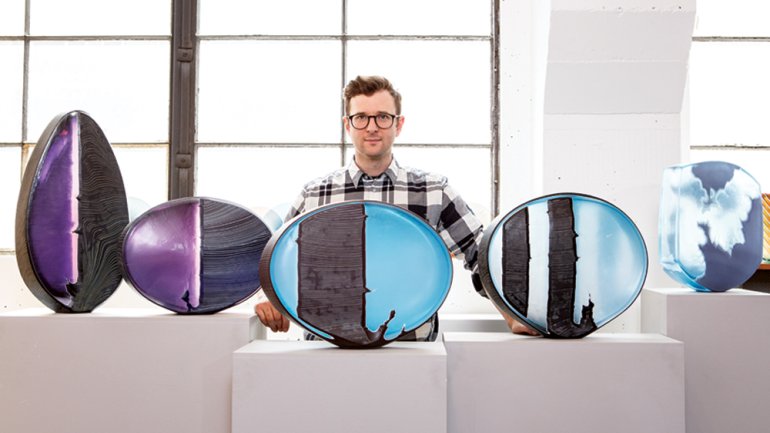Clear Cut
Clear Cut
Ethan Stern draws from the past, creating glass sculpture that's uniquely present.
Of all the tools in Ethan Stern’s Seattle studio, probably his favorite is a 1940s cast-iron lathe from a glass factory in Austria. He bought it a decade ago, after the factory closed, and has been using it ever since to help create his striking carved-glass sculptures.
“It’s an incredible machine, a perfect example of how they don’t build ’em like they used to,” Stern, 37, marvels. “It came with cutting wheels used in the factory, which was exciting because they’d already had a tremendous amount of life. I love getting to use these old wheels, make them work again. I’ve tried hard to use them in a way that feels unique to me.”
Using centuries-old techniques with vintage as well as modern tools, Stern makes works of art that are unique and striking. Blown asymmetrical forms based loosely on the vessel (averaging about 10 to 16 inches high), they’re lush with color, from fiery reds and icy blues to the subtlest gradations of white and gray. Their deeper shade of soul comes from the patterns, textures, and images Stern carves and engraves on their surfaces – abstract compositions of line and shape, angle and curve, opacity and translucence. He has explored these elements in various series, with themes such as Coastline (imaginary topography), Lunar Light (haunting spheres), and Structure Sound (the intersection of nature and industry).
While his work lives comfortably in the realm of contemporary art, Stern feels an affinity with the long tradition of cut glass. Pleased as he was to get his lathe, it underscored the fact that, in recent years, glass factories all over America and Europe have been shuttered, casualties of a changing economy. “All that history and tradition is kind of fading away,” he laments. (In turn, tools such as his lathe have become hard to come by.) It’s a sad reality but one that challenges and motivates him to pursue the craft. “I’m intrigued by that aspect of keeping something alive and making it relevant to a younger generation.”
Stern has been a dedicated maker since his teens. He grew up in Ithaca, New York, and took up ceramics in a serious way in high school. After he graduated, his father, a professor at Cornell, took the family on a year’s sabbatical to Brisbane, Australia, where Stern began formal studies at a ceramics college. (He also became enamored of the “simple yet complex” patterns of Aboriginal art, an influence that would later emerge in his work.)
Back in the United States, he enrolled at Alfred University’s School of Art and Design, intending to become a potter. But when he took a course in hot glass, he found himself powerfully drawn to the energy, intensity, and teamwork of that process. He started spending summers at the Pilchuck Glass School near Seattle, where he did various jobs, learned techniques, and watched master artists. He found his niche in cutting and engraving, which seemed, somehow, not too far removed from ceramics. “I realized that through cold-working I could approach glass as if it were clay, carving the surface and affecting it in a tactile way.”
He ended up with a degree in sculpture and glass, and for a time worked at Pilchuck and for other glass artists. Then he did a two-year residency at the Appalachian Center for Craft in Tennessee, an experience he credits with helping him find his voice. By 2005, when he settled in Seattle for good, his work was in shows and galleries around the country.
Today, assisted by his longtime team of Sam McMillen, Sean O’Neill, and Granite Calimpong, Stern blows his forms at a local hot shop, layering colored glass to achieve richness and depth. Back at his studio, he then cuts and engraves, a slower, solitary process. “That’s when I develop a relationship with the object, really experience the material and the surface, and have a dialogue with it.”
Looking back, he realizes he felt strangely guilty leaving ceramics for glass. “I think I went through this long period where I wanted to deny glass, what it really was,” he says. For years, he made surface areas look matte, almost claylike. Those effects are still in his repertoire, but now he’s into letting the glass shine. His latest works, called Crosscuts, are more polished and transparent, meant to capture and manipulate light. And with their orderly, straigh-tline geometric patterns, they’re the first works he’s done that pay overt homage to historical cut-glass design.
“I’ve been cutting in a more traditional way now than I ever have – more precise and planned, less spontaneous,” he says of this direction. “In a way, it feels lighter to me, like I came into something new.” Also new: Stern’s marriage last August to Amanda McDonald, a fellow artist whom he met at Pilchuck.
Starting new chapters has Stern thinking about the future – and, as always, its connection to the past. He wonders: In our informal, distracted, digital age, do we still care enough about art objects to invest in them and hand them down through generations, as people once did? As someone whose job is essentially to “reinterpret the heirloom,” he naturally hopes so. In the end, Stern says, it’s about “creating objects that people want to have around them, hold onto, and value.” A calling doesn’t get much more clear-cut than that.

